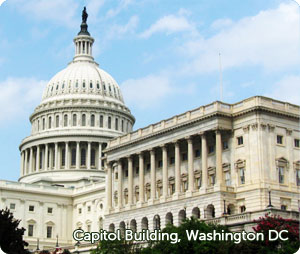Moving to Washington, D.C.
Washington, D.C. is home to our nation’s political gears. It is our nation’s capital, and the President, the U.S. Supreme Court, and our senators and representatives all live and work in Washington D.C., making the city a prime place for any aspiring politician, activist or lobbyist.
However, Washington, D.C. is more than just a political city. It is a beautiful city blossoming with history, culture and cherry trees. It also has a stellar array of arts, museums and activities for its residents.
Washington, D.C.’s Layout
Washington, D.C. is not part of any state; it’s a territory of the federal government. Only about 70 square miles large, it’s sandwiched between Virginia and Maryland. It’s located on the lowlands near the mouth of the Potomac River, about half an hour’s drive west of the Chesapeake Bay.
Washington, D.C. is split into eight “wards”. It is part of a larger metropolitan area that includes Alexandria and Arlington (Virginia) and a few counties in Maryland and that is home to over 4.5 million people. Washington DC is also about an hour away from Baltimore, a large city with its own metropolitan area. Together, they are home to over 8 million people.
Positives of Moving to Washington, D.C.
Politics – As the seat of our nation’s capital, Washington, D.C. has everything a diehard political follower would be interested in— Congress, the White House, and the Supreme Court of the United States top the list, and countless political groups, media companies and foreign embassies are based there as well.
Architecture – Washington, D.C. is a beautiful city with some amazing architecture, including the Capitol building and White House, and attractions, like the Washington Monument and the Vietnam Memorial. Tourists love visiting these sites, and if you move to Washington, D.C., you’ll have the privilege of seeing them whenever you want.
Cherry Blossoms – In 1912, Japan gifted the U.S. some cherry blossom trees native to its land. They were planted in Washington D.C., where they continue to thrive. They usually bloom in April, covering the city in white and pink. This is also when the National Cherry Blossom Festival is held in D.C.
Public Transit – Washington, D.C. has the third-most-used public transit system in the United States. Its subway system is recognized as one of the best in the world.
Museums – Washington, D.C. has tremendous museums, from the historical museums, like the Holocaust Museum, to science museums, like the National Air and Space Museum, to art galleries, like the National Museum of African Art. The Smithsonian Institute maintains most of Washington’s museums in pristine condition.
Negatives of Moving to Washington, D.C.
Weather – Washington, D.C. is known for uncomfortably cold weather in the winter and uncomfortably hot and humid weather in the summer. The best seasons to experience the nation’s capital are fall and spring.
Flooding/Hurricanes – The D.C. area is prone to hurricanes. Even without a hurricane, heavy rainfall can cause flooding to the low-lying plains the city is built on. Take the proper precautions before such a natural disaster creeps up on you.
Crime – Crime rates in Washington are gradually improving. At the moment, however, the city experiences more crime than most cities. Most criminal activity is concentrated in certain neighborhoods, so make sure to check crime maps before moving to the city.
Politics – Can a blessing also be a curse? Washington is a hotbed for political activity, which can be extremely exciting, but also extremely disrupting. Residents must grow accustomed to seeing protests and political rallies.
Want to move to Washington, DC? Then check out some Washington DC moving companies, which you can do right here: Washington DC movers.



